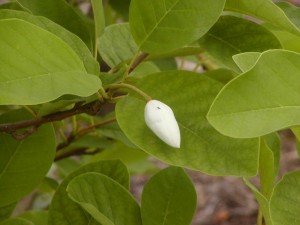Japanese cedar, aka cryptomeria, (Cryptomeria japonica) is the national tree of Japan and is also indigenous to China (USDA hardiness zones 5 to 8). Cryptomeria cultivars vary greatly from very dwarf to rounded shrubs to large tree forms. Needle-like foliage may be dark green, medium green, golden or contorted leaves. Cryptomerias tolerate hot humid summers and […]
Archive for the ‘Propagation (Cuttings)’ Category
What A Plant Costs
I overheard a customer complain about the “outrageous” prices for plants, particularly the newly introduced ones. Here is some of the whys: Certain plants are difficult to reproduce. Occasionally, stores may stock some expensive items like paperbark maple (Acer griseum) and fringetree (Chionanthus virginicus). These […]
Nellie R. Stevens Holly
Hollies and the winter season work well together. Female hollies with bright red fruits (yellow-fruited forms also) contrast with their glossy evergreen foliage. ‘Nellie R. Stevens’ holly (NRS), a female form, is a cross between English (Ilex aquifolium) and Chinese (I. cornuta) hollies. NRS is the popular holly choice in Southern landscapes (USDA hardiness zones 6 to 9). Hollies are dioecious, […]
List of Zone 6 Hardy Camellias Grows Longer
If you live and garden in USDA hardiness zone 6, several camellia cultivars are winter hardy. The past decade has seen an increase in the list of hardy cultivars. These same cultivars are also reliable planted in zone 7. Here is a sampling of the best Zone […]
Nativars – New Cultivars Of Native Plants
Nativar is a new term coined by Dr. Allan Armitage, Professor Emeritus from the University of Georgia. It combines the words “native” and “cultivar”. Nativar refers to a cultivar of a native plant. It attempts to excite the horticultural marketplace about new cultivars of native perennial plants, such as blackeyed Susan (Rudbeckia spp.), purple coneflower […]
‘Grey Owl’ Juniper Is Tough Carefree Evergreen
Some people rate junipers as over-planted or bygone landscape plants. Juniperus virginiana ‘Grey Owl’ is a cultivar of our native Eastern Red Cedar (USDA hardiness zones 3 to 9). Eastern red cedar is actually a juniper. This flat spreading evergreen develops into a reliable ground cover not plagued with disease and pest problems observed on […]
Summer Blooming Oyama Magnolia

A friend on vacation sent me the attached photo from Wooster, Ohio. When I told him that it was Oyama magnolia (Magnolia sieboldii), he asked why gardeners are not growing it. Good question! Oyama magnolia is a 10-15 feet tall (and equal spread) deciduous tree or large shrub from eastern Asia. It prefers to grow […]
Summer Pruning of Oakleaf and Bigleaf Hydrangeas
Bigleaf or “mophead” hydrangeas (Hydrangea macrophylla) tend to get tall and leggy, and outgrow their garden space. Our native oakleaf hydrangeas (Hydrangea quercifolia) are pruned as blooms quality declines. Remove or “deadhead” all withered or faded flowers. Main pruning time for these two species is from mid-June thru mid-August. Mopheads may rebloom if they had […]
Double Take™ Flowering Quinces
Photo credit: Dr. Tom Ranney, NCSU Research Horticulturist Flowering quince (Chaenomeles spp) is an early spring flowering shrub, treasured for its brightly colored blooms (USDA hardiness zones 5-9). Old fashioned quince shrubs produced small amounts of fruits which were gathered and prepared into yummy jelly in the autumn kitchen. These often large 10-12 foot tall shrubs produced small sharp […]
Opening Show in February- The Witchhazels
First, not to confuse you, our North American native witchhazel (Hamamelis virginiana) blooms in the fall. Our native vernal witchhazel (H. vernalis) has been flowering for the past few weeks. In February, the showiest witchhazels are opening now – species from China, Korea and Japan. Two of the very best are a Chinese species/cultivar called […]

 Posted in
Posted in 
 Tags:
Tags: 
